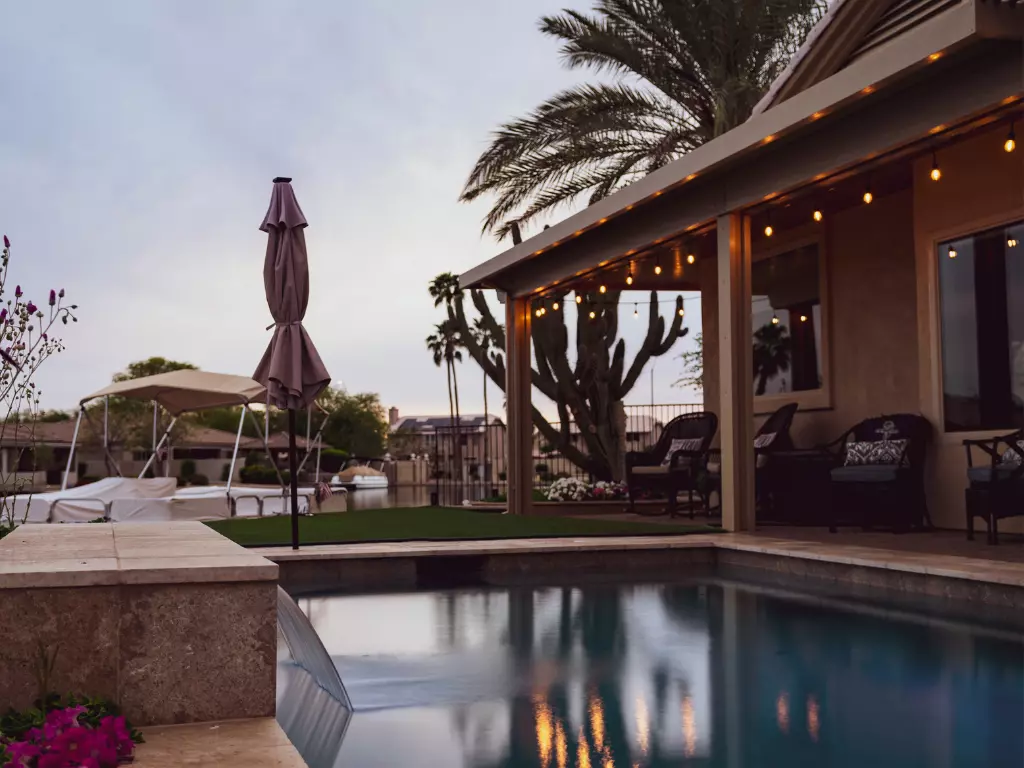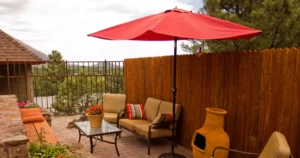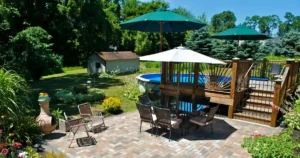Whether you want to host intimate dinner parties or simply unwind after a long day, don’t feel limited by the size of your patio. With some creative small patio lighting ideas, even a compact outdoor space can feel inviting long after sunset.
Similar to larger patios, lighting allows you to make the most of your small area. It enables leisurely evening meals, relaxing get-togethers with friends, or solitary moments to take in the fresh air at night. Beyond setting the mood, practical lighting also highlights paths and design accents.
Of course, limited square footage means the lighting plan needs special attention. On a small patio, each fixture’s placement serves an important purpose. In this guide, I’ll share ideas and tips for crafting a lighting scheme tailored to your space.
We’ll explore how lighting defines an area’s character. Various fixture types suit different needs too, from wall sconces to string lights. Then we’ll discuss fixture placement – where every spotlit section promotes safety while socializing or movement after dark.
By the end, you’ll gain inspiration and strategies for individualizing a lighting design that matches your patio lifestyle. Whether touring guests or solitary nights outside, this will help make the most of your compact outdoor haven as evening falls.
Why Proper Lighting is Essential for Small Patios

Your patio may be on the smaller side, but the right lighting can make it feel spacious even after dark. A well-lit patio transforms from an unusable space at night into a welcoming outdoor oasis. During the day, some accent lighting adds personality.
Lighting opens up possibilities for your compact patio. Whether you want to host low-key gatherings, enjoy dinner outdoors, or unwind alone later, lighting makes it feasible. Beyond setting the vibe, lights also help highlight special design details.
Some main reasons to light your little patio:
- Safety: You don’t want anyone tripping in the dark! Lighting ensures visibility around furniture and walkways.
- Security: Bright lights help deter unwanted visitors at night and give you peace of mind.
- Ambiance: Mood lighting creates a relaxing ambiance for different activities.
- Task lighting: Pinpoint lights help with food prep, games, and conversations as needed.
- Architectural enhancement: Highlights architectural features like arbors, columns, walls, and statuary.
- Landscape enhancement: Shines light on plants, trees, and water features to accentuate textures, colors, and details.
- Boundaries: Designates the patio area and provides separation from the rest of the yard.
Small Patio Lighting Basics
When it comes to lighting up your small patio at night, careful planning and strategic placement are what truly make a difference. With some thought put into design, you can create a cohesive and impressive look even in a limited space.
Here are a few basic guidelines that will help pull it all together:
- Establish focal points – Decide which architectural or landscape elements you want to highlight and install targeted fixtures. For small spaces, limit focal points to 1-2.
- Illuminate gathering areas – Use overhead and task lighting to brighten conversation and dining spots. Wall sconces by seating work well.
- Light walkways – Mark transitions and outline paths with downlights or low-voltage lights. This guides traffic flow.
- Hide light sources – Conceal wires, cables, transformers, and LED strips for a clean look. Uplighting and recessed fixtures minimize glare.
- Substitute reflective surfaces – Add mirrors, glass tables, light pavement, and water features to bounce and amplify light. Metallic finishes also create shine.
- Use dimmers and timers – Control brightness and automatically turn lights on/off for convenience and cost savings.
- Check electrical load capacity – Avoid overloading circuits by remaining within your home’s capacity and using low-voltage fixtures.
Top Lighting Types for Small Patios

When lighting a small patio, the fixture style you choose really matters. To make the most of limited space, you’ll want options that match your needs while staying compact. Here are some of the most useful varieties:
Ambient Lighting
This provides overall illumination across the entire patio. Ambient lighting makes the space usable at night and allows safe navigation.
- Flush mount ceiling lights – Offer a smooth look when mounted to the ceiling. Choose weatherproof fixtures.
- Hanging pendant lights – Add stylish overhead lighting and work with low ceilings. Opt for pendants sized appropriately for the space.
- Post lights – Freestanding units placed around the patio periphery provide ambient glow from all directions.
- Recessed soffit lighting – Discreetly recessed units inserted into soffit overhangs gently wash the space with light.
- Lanterns – Classic portable units made of metal, glass, and other materials give off wide-reaching light. Their raised style brings light to face level.
Task Lighting
Task lighting targets specific functional areas for activities like cooking, playing games, and eating.
- Under cabinet lights – Discreet LED strip lighting illuminates countertop tasks. Hardwired or battery-powered options are available.
- Step lights – Sunken units placed on each step provide safe illumination on stairways. LEDs shine down to prevent tripping.
- Table/floor lamps – Freestanding portable lamps lend focused light to play board games, eat, and more. Waterproof and rechargeable choices are ideal.
Accent Lighting
Accent lighting Spotlights architectural details, plants, and other focal features. This adds drama and interest to small patios.
- Wall sconces – Wall-mounted units placed by seating areas, steps, and other zones provide both task lighting and accents.
- Path lights – Low-voltage lights inserted along walkways and around the perimeter highlight routes and boundaries.
- Spotlights – Adjustable fixtures project narrow beams onto plants, artwork, and other accents for targeted illumination.
- Flood lights – Also adjustable, these widen the beam to splash light across a specific area or architectural feature.
- In-ground well lights – Sunken fixtures uplight trees, walls, and other features from below to highlight textures.
- Decorative fixtures – Items like lanterns, candle holders, hanging baskets, and torch lamps accent while adding light.
For various small patio lighting options that may provide additional inspiration, visit wayfair.
Lighting Tips for Small Patios
Maximize usable space and create an inviting ambiance on a compact patio using these fundamental lighting strategies:
Direct Light Downward
Excessive glare from light aimed at eye level or upward causes discomfort and makes it hard to see. Position most fixtures to shine light down and diffuse glare. Overhead and step lighting is ideal. If using accent-up lights, face them away from seating areas.
Hide Light Sources
Exposed bulbs and excessive lighting hardware look cluttered on small patios. Minimize the view of wires, transformers, and LED strips by hiding them behind plants or architectural elements. Recessed, concealed, and indirect lighting keeps the focus on the light itself.
Warm Color Temperatures
Cool LED and fluorescent lighting have an irritating clinical glare. Warm light in the 2000 to 3000K range feels more inviting and renders colors accurately. Warm white light achieves both ambiance and functionality.
Illuminate Vertical Surfaces
Light-reflecting off architectural elements like walls, trellises, tile, and railings helps expand a sense of space. Up-lighting, wall sconces, and lanterns bounce light for a cohesive look. Just avoid glare.
Use Dimmer Switches
Installing dimmers allows you to control a fixture’s brightness level. Dimming creates ambiance for evenings and saves energy for unoccupied times. Dimmers work with LED, incandescent, and halogen.
Mix Lighting Types
Combine ambient, task, and accent lighting to balance overall visibility with dramatics. Wall-mounted sconces by seating areas boost ambiance and practicality.
Add Lighting Layers
Build up light levels with a layered lighting plan. Ambient and task lighting generates the base glow while accent lights add spotlighting. This varied combination prevents a dark and flat look.
8 Inspiring Small Patio Lighting Ideas

Now that the sun sets earlier each evening, I’ve been dreaming up ways to extend my time relaxing outdoors even as night falls. The problem is that my patio, while cozy during the day, feels cramped and dim once it gets dark. I wanted to transform it into an inviting oasis after hours without taking up much valuable square footage.
After browsing lighting ideas online, I started brainstorming affordable schemes that could fit my petite space. Many emphasized clever focal points, reflected illumination, and perimeter lighting to frame the area subtly. Armed with inspiration, here are some techniques I’ve tested that have seriously upgraded my patio’s nighttime vibes without sacrificing usable space.
1. Wrapped Overhead Ambient Lighting
Running low-voltage rope lights around the entire patio perimeter washes the space in a warm, continuous glow. The indirect lighting from above provides excellent ambient illumination while hardly taking up any room at all.
2. Focal Fire Feature
Centering the layout around a fire feature like a fire https://patiocharms.com/how-does-a-smokeless-fire-pit-work/pit, chimenea or fire bowl makes it the star. Accent lighting directed at the flickering flames creates drama and coziness. Additional ambient lighting lets people safely gather around it.
3. Potted Plants as Focal Points
Strategically up lighting colorful potted plants and containers creates vivid focal points. This also accentuates their textures. Mixing matte and glossy planters amplifies the effects.
4. Reflective Surfaces Bouncing Light
Incorporating reflective materials like glass tabletops, metal chairs, pillars, and ceramic tiles multiplies ambient lighting effects. They also add shimmer without needing numerous fixtures.
5. Perimeter Downlighting for Boundaries
Running LED lighting strips around the patio edge outline the shape and boundaries. The discreet down-firing illumination also increases safety and visibility.
6. Backlit Built-In Seating Nooks
Tucking LED strip lighting or rope lights behind built-in bench seating/nooks backlights the feature for an inviting glow.
7. In-Ground Well Lights Highlighting Hardscaping
Recessed well lights shine upwards onto the patio’s tiled, stone, or concrete surfaces from within planter borders or along pathways. This washes architectural elements with ambient light.
8. Under-Cabinet Task Lighting
Installing slim under-cabinet LED strips on any built-in cooking or bar areas provides targeted downlights where you need them most for food prep tasks.
Final Thoughts
With careful planning and multipurpose fixtures, small patio lighting can enhance safety, usability, and ambiance without overwhelming limited space. The key is selecting versatile options that spread illumination from multiple angles. Layers of ambient, task, and accent lighting prevent dark areas while establishing intimate zones. Don’t be afraid to utilize surrounding vertical planes and reflective materials to bounce light efficiently. Most importantly, have fun experimenting with lighting schemes that suit how you enjoy your outdoor retreat.
Frequently Asked Questions (FAQs)
Q: What types of lighting are best for small patios?
Versatile options like recessed/soffit lights, lanterns, path/step lights, and wall sconces adequately light small spaces.
Q: Can you provide lighting examples for specific small patio layouts?
Yes, fixtures placed to highlight built-in seating, accent focal plants/water features, or backlight railings suit various configurations.
Q: What wattage bulbs should I use in patio lights?
Stick to low-wattage bulbs (60w equivalent or less) to save energy. LED is the most efficient. You may need multiple lower-wattage fixtures versus one bright light.
Q: How do I install lights safely outdoors?
Only use lights rated for wet locations. Hire an electrician if running new wiring. Place GFCI outlets near the water. Check for damaged cords before use.
Q: How do I prevent glare from small patio lights?
Downward-facing fixtures, conceal light sources, use frosted/translucent shades/globes, and install at low heights to avoid glare in the eyes.
Q: What if my patio has limited electrical access?
Opt for battery-powered or solar lighting options that don’t require wiring. You can also use extension cords and surge protectors safely outdoors.
Q: Do I need a permit for patio lighting installation?
In most areas, basic lighting projects like adding low-voltage fixtures or replacing bulbs typically don’t require a permit. But check local codes for wiring permanent fixtures to existing circuits.
Q: How do I tell if my patio’s electrical system can support more lighting?
Check the circuit breaker for the circuit your patio is on. Make sure the total wattage of new/existing fixtures doesn’t exceed the rating. You may need an electrician to add a new circuit if overloaded.
Q: What’s the best way to run wires and cords for patio lighting?
Secure cords and wires safely along walls, ceilings, or lighting frames out of walkways. Use staples designed for outdoor use and cover with decorations when possible.
Q: How often should I clean patio lights?
Wipe down fixtures monthly to remove dirt, pollen, and debris buildup. Clean lenses and change bulbs yearly or as needed. Inspect wires for damage after storms.
Q: Can I leave patio lights on all night?
It’s best to use timers or photosensors to automatically shut lights off after dusk to conserve energy. Leaving them on raises utility bills and light pollution.
Q: What should I do if a patio light fixture stops working?
Check the bulb, fuse/GFCI, or transformer first. Lightning or power surges may cause failures. Replace defective parts or whole fixtures if needed with matching waterproof models.
Q: How can I highlight planting beds with lighting?
Use low-voltage in-ground-up lights, solar path stakes, or low-wattage rope/string lights installed at bed edges and aimed into the foliage for subtle accents at night.
Q: What’s the best way to add lighting to an uncovered patio?
Free-standing post lights, ceiling fixtures, string lights, and lanterns offer flexibility. For ambient glow, run perimeter lights under the overhang or along the house edge.







